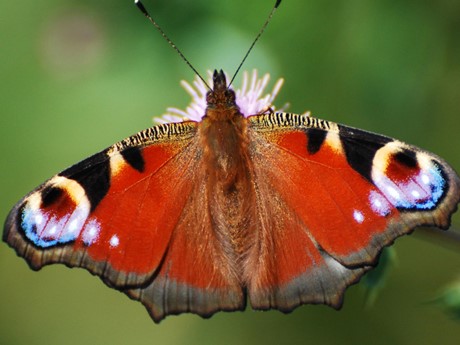Are the swifts late in 2021?
Lorienne Whittle, 07/05/2021
Citizen scientists have been submitting their 'first recorded' swifts to Nature's Calendar for many years, in fact we have records going back to 1907! House martins, sand martins, swallows and swifts all migrate back to the UK after overwintering in Africa. Our Phenology Calendar shows swifts usually the last to arrive.
More research is needed on the 'push' and 'pull' factors that stimulate bird migration and your records can help us better understand this phenomenon. On Nature’s Calendar you can record your first swift sighting and your last glimpse at the end of summer. Here’s more detail on what you need to know for successful recording.

Swifts only land to breed, they even sleep on the wing (Photo: Steve Young Alamy)

Swifts have a small white patch under their chin (Photo: David Tipling Alamy)
Identification
Swifts are generally seen in the sky as they hunt for insects. From this viewpoint the distinctive features are the dark underside and the long, scythe shaped wings. Their flight is characterised by fast, frantic wingbeats followed by long genteel gliding.
When you’re recording for Nature’s Calendar, it is important to know the difference between swifts, swallows and house martins. Our swift recording page gives more detail and photo comparison.
When do swifts arrive in the UK?
From the start of April our citizen science recorders regularly check the UK’s skies for the arrival of the first swifts after their 6000 mile flight from the south Sahara. Most are first spotted around the end of April or the beginning of May.
The best time of day to look out for them is early morning or dusk. They hunt for insects high above the ground. You are more likely to see them around their preferred nest sites of rooftops, ventilation shafts or church towers.
Swifts are monogamous, meaning they pair for life with their breeding partner. They are also loyal to nest sites which they return to for up to 15 years. Swifts produce one brood of two or three eggs each spring, which they lay two or three days apart. This ensures successful fledging of at least one chick as it spreads out the demand for food and allows for insect fluctuations.
The spring arrival date tends to be quite predictable compared to the late summer departure.

Swift arrival is usually more predictable than winter departure (Photo: North East Wildlife)
Recording to detect change
All the natural events you can record on Nature’s Calendar have been chosen to help us study the impact of weather and climate change on wildlife. Swifts are a suitable species as they are found in urban and rural settings and can be easily recognised. We have a lot of records, dating back to 1907, so it is important to collect current first sightings for comparison.
Swifts used to be far more common. Their conservation status in the UK has moved from 'Green' to 'Amber' in the last 10 years due to population decline and a reduction in the areas they are found to both breed and over winter in. A lack of insects (their food source), a lack of nesting sites and climate change have all been cited as reasons for swift population numbers and distribution has reduced.
How does 2021 compare?
In terms of phenology - the timing of natural events - spring 2019 and 2020 were both considered to be very early years. This is what we found, across the vast majority of natural events, by collating and analysing your spring records for these years.
The phenology events recorded so far in 2021 are showing to be, on the whole, a little later, and certainly when compared to these recent early years. Our live map, which shows records as they come in for each natural event, is a really useful tool for comparing the timing of the same event between years.
Below is a the live map for swifts, taken on 7th May, for an easy visual comparison across the last few years.

First recorded swifts, 07.05.2018

07.05.2019

07.05.2020

07.05.2021
When do swifts leave the UK?
The presence of swifts is often most obvious in July and August when the newly fledged young join the adults in swooping flight and screeching calls. The chicks only fly the nest once they are up to the minimum weight for the migration, they and their parents then return to Africa after only a couple of days of flying practice.
Their departure date depends on the success of breeding. If there are lots of insects and the chicks have fattened up quickly, they leave earlier. They also leave early if their breeding attempt is unsuccessful. If the summer is damp and cool there are fewer insects and it takes longer to feed up the chicks to the ideal weight for fledging and they leave later.
How to record swift last seen
Keep watching the sky from mid-July onwards. Make a note of the date each time you see a swift until you no longer see one. The last date you saw a swift is the date to record with us, they normally leave by the end of September. This data is really valuable to us.
Start swift watching
Keep an eye on the summer swifts near you and help us study them by recording the first and last one you see in your area. The more we know about swifts across the UK the more we will be able to help implement effective conservation strategies.
Read 'Which birds migrate?' to learn more about species you can look out for over the summertime.

